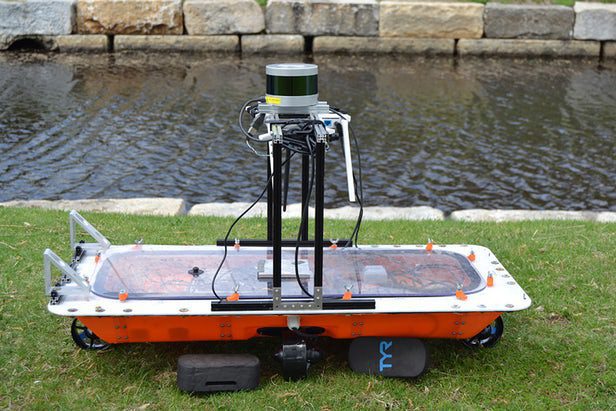Researchers from MIT CSAIL and the Amsterdam Institute for Advanced Metropolitan Solutions are working on a project called the RoBoat, an autonomous boat system that can be used as water taxis, or even be joined together to create floating structures and bridges.
Imagine being able to start your morning off by hopping on a driver-less water taxi that takes you straight to work, avoiding rush hour traffic and a giant headache. That efficient and automated future sounds like it’s an ocean away from reality, right? Well, not particularly…
MIT’s Computer Science and Artificial Intelligence Laboratory (CSAIL) and the Amsterdam Institute for Advanced Metropolitan Solutions are working on a project called the RoBoat. The collaborative idea is to create autonomous boats that will move passengers and cargo across bodies of water and around the city, freeing up the roads.
These autonomous boats could be used as water taxis, or can even join together to create floating structures that could be used as bridges, jetties and platforms for concerts.
If you’ve ever traveled to Amsterdam, you already know that the complex network of canals makes it the perfect place to conduct trials with the boats. Back in 2016, the RoBoat team tried out their prototypes in the city’s water channels. They sent the small boats down a preprogrammed path, testing out how well the onboard sensors and electronics worked.
The test went well, but researchers have continued to tweak and test the design further. So far, they’ve made the manufacturing process a lot easier by utilizing 3D printing to create the hull of the boat.
“Imagine shifting some of infrastructure services that usually take place during the day on the road – deliveries, garbage management, waste management – to the middle of the night, on the water, using a fleet of autonomous boats,” says Daniela Rus, co-author of a new paper describing RoBoat’s progress.
Using 3D Printing to Improve the Design of the RoBoat
In order to 3D print the boat’s hull, which measures 4 m x 2 m, the team used an industrial 3D printer. The hull consisted of 16 separate pieces, and entire printing process took 60 hours.
The team also managed to make the boats lighter and quicker by placing thrusters in the center of each of the four sides. This also allows the autonomous ship to easily move forwards, backwards and laterally too.
To ensure the boats are can navigate independently, they carry a GPS onboard that can pinpoint an exact location within centimeters while outdoors. However, when sailing indoors, this tracking system primarily relies on an ultrasound beacon system.
The boat also carries a power supply, Wi-Fi antenna, a minicomputer and micro-controller. There’s also an inertial measurement unit (IMU) onboard that keeps the boat from tipping over and consistently measure that direction it’s facing.
“The controller considers the boat dynamics, current state of the boat, thrust constraints, and reference position for the coming several seconds, to optimize how the boat drives on the path,” says Wei Wang, first author of the study. “We can then find optimal force for the thrusters that can take the boat back to the path and minimize errors.”
Another key element of the RoBoat project is an algorithm that controls the boat. This algorithm takes centrifugal forces, drag and changing mass into account while the boat changes speed.
To test out this advanced system, the researchers preset paths in a swimming pool and set sail to a mini RoBoat. Not only was their initial test were a success, but over the course of 10 total test runs, only a couple of tracking errors occurred.
Nonetheless, there is still more work to be done. In the future, the researchers will be finding ways to incorporate the ever changing mass of cargo or passengers while also taking into account currents and waves.

Source: MIT
Website: LINK

